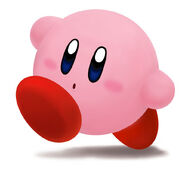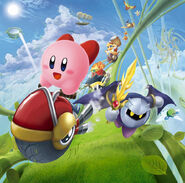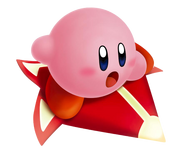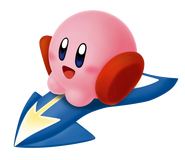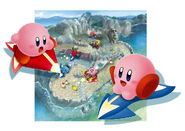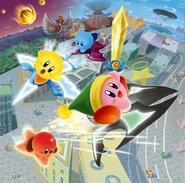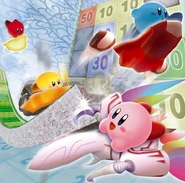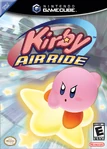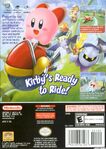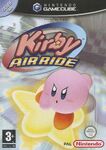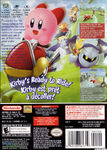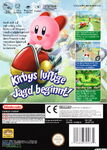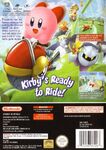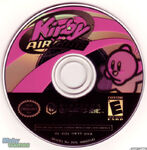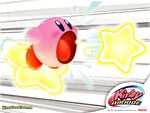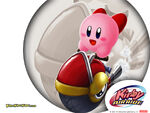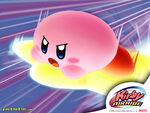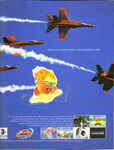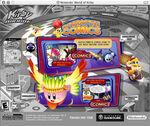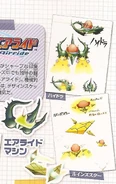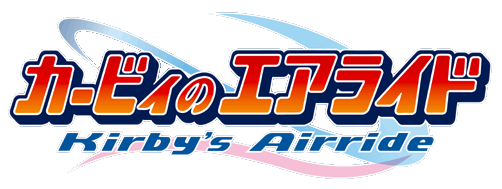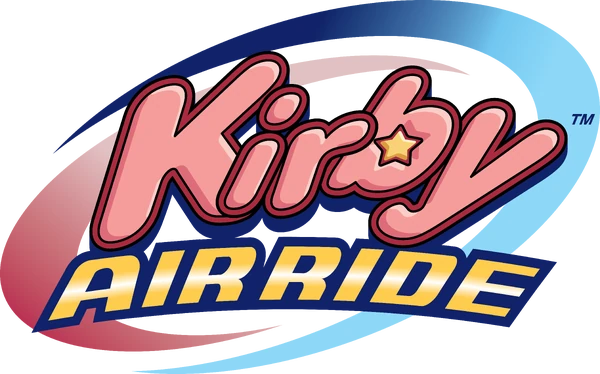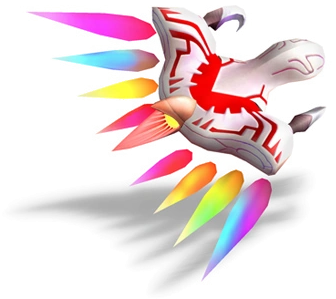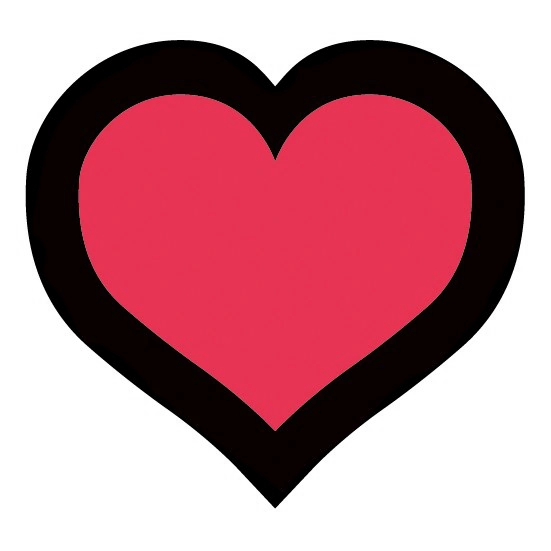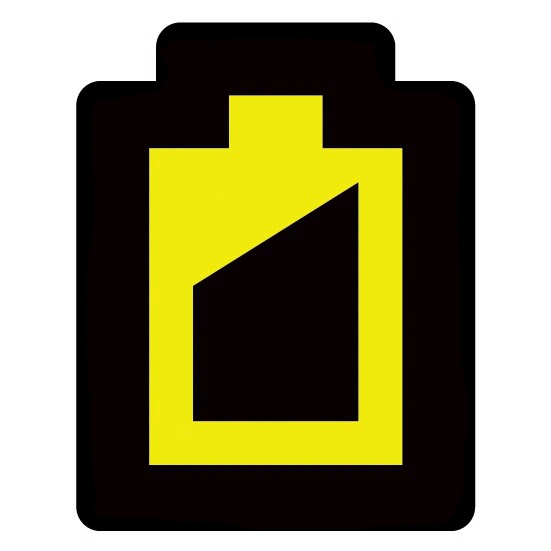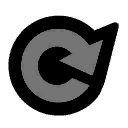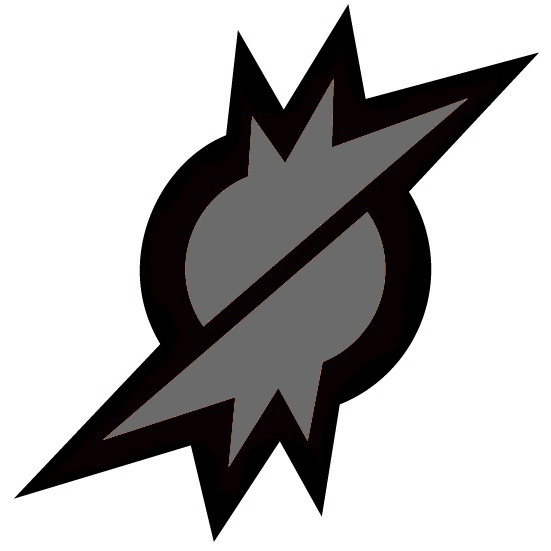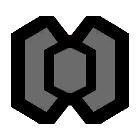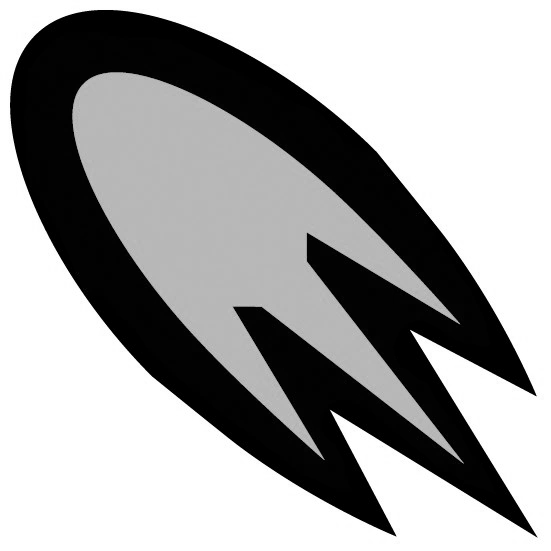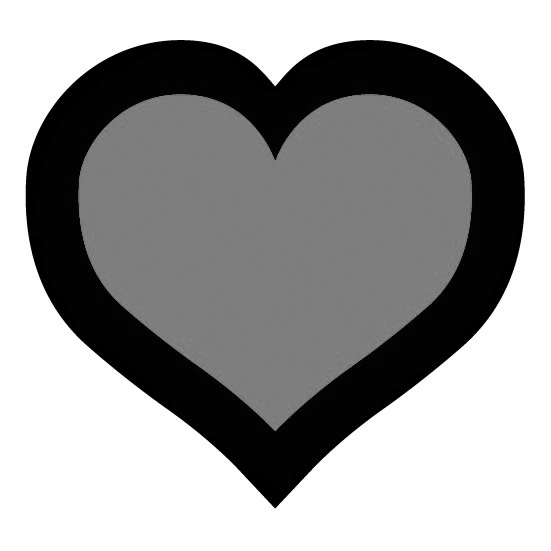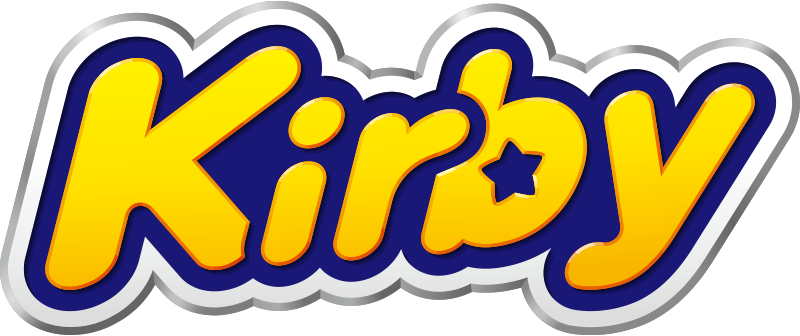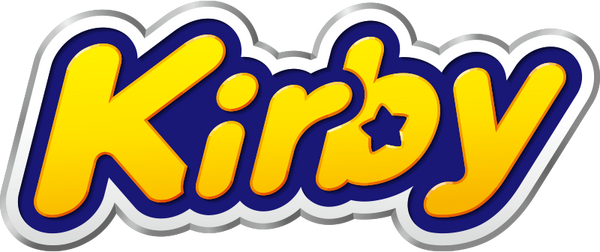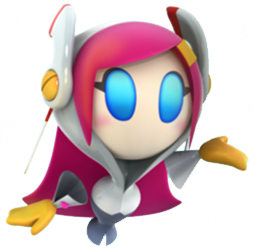
|
This article is about the 2003 Nintendo GameCube game. For the sub-game in Kirby: Nightmare in Dream Land, see Kirby's Air Grind. For the sub-game in Kirby & The Amazing Mirror, see Kirby Wave Ride. |

|
"Kirby's Airride" redirects here. For the cancelled game for the Nintendo 64, see Kirby's Air Ride. |

|
"Airride" redirects here. For the mode, see Air Ride. |
| “ | Kirby Air Ride included many different high-speed racing modes. The controls for this game may have been simple, but becoming a top-scoring Air Ride racer took lots of practice and strategy. Players who were good at handling their Air Ride machines and Kirby's Copy Abilities could look forward to unlocking special characters.” |
| — Summary • Kirby's Dream Collection Special Edition |
Kirby Air Ride is a racing Kirby game developed by HAL Laboratory and published by Nintendo for the Nintendo GameCube. It was released in Japan on July 11, 2003, in North America on October 13, 2003, in Europe on February 27, 2004, in South Korea on March 4, 2004 and in Australia on March 30, 2004.
Intro[]
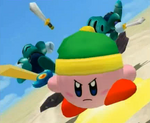
Part of the game's intro
Kirby races against two Broom Hatters. He swallows a Heat Phanphan and throws Fire on the ground, burning the two and KOing them. Then, actual game clips play. Suddenly, two Sword Knights appear in front of Kirby. With his Sword, he slices the two, KOing them. Kirby then flies off a ledge, where Meta Knight charges toward him, fading to white. Then, Kirby, along with Yellow, Red, and Blue Kirby, race off into the distance.
Gameplay[]
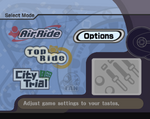
The game's three modes
Kirby Air Ride is a racer in which characters use Air Ride Machines to race through courses, or in a city. Kirby is the starting character, but King Dedede and Meta Knight, as well as different color variations of these characters, are unlocked by ticking certain boxes in the Checklist. Dedede and Meta Knight are only available for use in Air Ride and the Free Run mode (while playing City Trial), always use the same vehicle, and if they crash, they cannot return to an upright position and are trapped in a permanent death state.
Copy Abilities return in Air Ride and City Trial modes, and are collected either by inhaling enemies or by using a Copy Chance Wheel.
Modes[]
Kirby Air Ride contains three modes: Air Ride, Top Ride, and City Trial, each unique to one another.
Air Ride[]
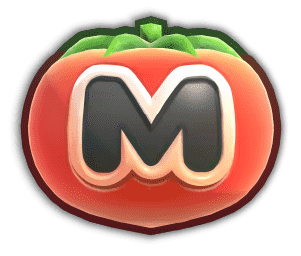
|
Main article: Air Ride |
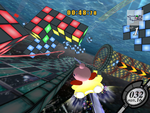
Checker Knights, an Air Ride course
In Air Ride, players can choose a machine, the number of racing opponents, and race in 1 of 9 different courses, one of which is unlockable. The player cannot race alone, however. At first, the only vehicle available is the Warp Star, but progress unlocks other Air Ride Machines and playable characters. The player can race in Time Attack mode, which is a race against time over as many laps as the player sets, or Free Run mode, which is a race against the player's best time.
Top Ride[]

|
Main article: Top Ride |
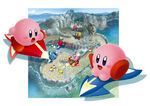
Official artwork of Top Ride
In Top Ride mode, the camera is directly overhead the rider and Machine, and controls remain the same, but gliding is not enabled. Kirby is the only character choice for this mode and he has the option of using the Free Star or the Steer Star. Players have a choice of 7 courses. The player can race against opponents, against time, or against his/her best time.
City Trial[]

|
Main article: City Trial |
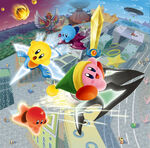
Official artwork of City Trial
Players are given a set amount of time to wander around in a large city area. The main objective is to collect as many patches as possible to enhance his/her machine in order to give them an edge when they subsequently compete in the Stadiums. The player always has the option to abandon his/her machine in favor of another one at any time. Events may occur throughout the game. The player can compete in Stadium mode, and Free Run mode lets players cruise around the city with unlimited machine use and no time constraints.
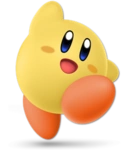
|
See also: Events |
Controls[]
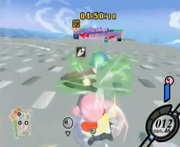
Kirby performs a quick spin on a Compact Star.
The game's default control scheme involves the A Button, Control Stick, and C-Stick. The Control Stick steers vehicles, executes Quick Spin attacks (rotate left/right), and descends/escalates non-Wheelies in flight (up/down, respectfully). The C-Stick adjusts the camera angle and zooms in/out on Kirby. All the Machines accelerate automatically. Holding down the A Button brakes and fills the Boost Gauge in the lower-right corner of the screen. Releasing the A Button will drain the Boost Gauge, and when the Gauge is full or near-full, the Machine will gain a burst of speed. If Kirby maintains the Boost Gauge at full for too long with most Machines, it will burn out, causing Kirby to recharge.
By slowing down upon entering bends and flying out of them by boosting, players recover lost time spent turning and accelerate back to top speed. Boosting along straights, however, is counterintuitive; this results in an overall lower speed. Certain Machines have unique boost characteristics, such as using it to fuel up, or not boosting at all.
Air Ride Machines glide upon hitting ramps or ledges. While gliding, tilting the control stick up/down pitches the Machine down and up (respectively), and left/right banks the Machine left and right. Holding the A Button brings the Machine to the ground, cancelling the glide.
Players perform Quick Spin attacks by quickly rotating the Control Stick left or right. This is the primary method of attacking. Ramming into other vehicles at high speeds damages opponents in City Trial. If timed right, the player is also able to dodge attacks. Copy Abilities also cause damage, and are obtained from non-player enemies, Copy Panels, and Red Boxes (in City Trial).
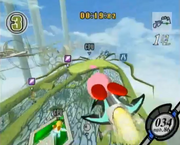
Kirby glides on a Jet Star.
In City Trial mode, the player can hold button A and tilt down on the control stick to have the character jump out of his/her vehicle and find a new one to use. On foot, the character may run around and jump, and is able to perform up to 5 consecutive air jumps. When the character touches another machine, he will hop onto the machine automatically. If the player is playing as Kirby and he manages to grab a certain number of patches before this, he will cough up some patches as soon as he collected enough.
The C-stick in this game is used for rotating the camera around the Machine and zooming in and out. Full rotation is not enabled, and the camera cannot go into the 90-degree arc at the front of the Machine. In the Pause Screen, the player can rotate the camera in all 720 degrees, but the camera will not go into the ground or through the Machine.
Characters[]
Playable Characters[]
Kirby[]

He is the default character and his speed depends on his vehicle. Kirby can be used in all three modes of the game. He can also use Copy Abilities and collect patches.
Red, Blue, Yellow, Green, White, Purple, and Brown Kirbys are playable, but four of them need to be unlocked in each of the three modes separately beforehand by completing certain Checklist objectives.
King Dedede[]
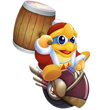
He is the most powerful character and has the highest HP of the three. One swing alone can deduct a large amount of health. Dedede's weapon of choice is his hammer. His main drawbacks are his low speed and high weight. King Dedede can only be used in the Free Ride mode of City Trial and Air Ride. King Dedede cannot use Copy Abilities or collect patches.
Meta Knight[]

Meta Knight is quick and has powerful attacks. He is one of the fastest characters in the game and uses his sword, Galaxia, to attack for high damage. He also glides extremly high, higher than the Winged Star and Flight Warp Star. However, he has very low defense and HP, so he can only take a couple of hits. Meta Knight can only be used in the Free Ride mode of City Trial and everywhere in Air Ride. He cannot use Copy Abilities or collect patches.
The player can play in different colored King Dededes and Meta Knights as well as Kirbys.
Enemies[]
| The following section contains transcluded content from the Database. Source: (view • edit • help) |
Balloon Bomber | Bronto Burt | Broom Hatter | Caller | Cappy | Chilly | Dale | Flappy | Gordo | Heat Phanphan | Noddy | Pichicri | Plasma Wisp | Scarfy | Sword Knight | Waddle Dee | Walky | Wheelie
Air Ride Machines[]
For the role of the Machines in Kirby: Right Back at Ya!, see Air Ride Machine
Machines/Characters in both Air Ride and City Trial[]
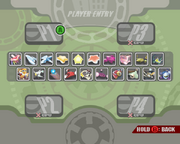
All of the machines in City Trial's Free Run.
- Warp Star
- Slick Star
- Winged Star
- Formula Star
- Shadow Star
- Swerve Star
- Rocket Star
- Wagon Star
- Turbo Star
- Jet Star
- Bulk Star
- Wheelie Bike
- Wheelie Scooter
- Rex Wheelie
- Meta Knight (Air Ride: All courses; City Trial: Free Run only)
- King Dedede (Air Ride: All courses; City Trial: Free Run only)
Top Ride-only Machines[]
City Trial-only Machines[]
Machine Abilities[]
 HP: HP represents the amount of damage a Machine can sustain. The amount of HP left is shown by the Damage Bar on the upper right of the screen. On Air Ride matches with the Damage Gauge turned off, the Damage Bar is hidden, but vehicles can still sustain damage and be destroyed. Upon reaching zero HP, a Machine is destroyed. Having any non-zero HP lower than the maximum does not impact a Machine's performance, however.
HP: HP represents the amount of damage a Machine can sustain. The amount of HP left is shown by the Damage Bar on the upper right of the screen. On Air Ride matches with the Damage Gauge turned off, the Damage Bar is hidden, but vehicles can still sustain damage and be destroyed. Upon reaching zero HP, a Machine is destroyed. Having any non-zero HP lower than the maximum does not impact a Machine's performance, however. Top Speed: Top Speed is the highest speed a machine can attain. It is essential to have this on relatively straight courses such as Drag Races and the Single Race course Nebula Belt.
Top Speed: Top Speed is the highest speed a machine can attain. It is essential to have this on relatively straight courses such as Drag Races and the Single Race course Nebula Belt. Boost: Boost determines a machine's automatic acceleration and the speed boost when releasing the charge from the Boost Meter. The higher the machine's boost rating, the sooner it can reach its top speed and the faster it goes when releasing a boost charge.
Boost: Boost determines a machine's automatic acceleration and the speed boost when releasing the charge from the Boost Meter. The higher the machine's boost rating, the sooner it can reach its top speed and the faster it goes when releasing a boost charge. Charge: Charge determines the amount of time it takes fill up the Boost Gauge when Button A is held down. The higher the charge rating, the faster the Gauge fills.
Charge: Charge determines the amount of time it takes fill up the Boost Gauge when Button A is held down. The higher the charge rating, the faster the Gauge fills. Turn: Turn determines the maximum angular rotation a Machine can perform. The higher the turn rating, the faster and tighter it can turn.
Turn: Turn determines the maximum angular rotation a Machine can perform. The higher the turn rating, the faster and tighter it can turn. Offense: Offense determines the amount of HP damage inflicted on other players upon contact. Offense is disregarded in game modes which do not involve HP bars. High offense gives more damage.
Offense: Offense determines the amount of HP damage inflicted on other players upon contact. Offense is disregarded in game modes which do not involve HP bars. High offense gives more damage. Defense: Defense determines the reduction of HP damage received when enemies collide into the player's Air Ride Machine. High defense means less damage received. Defense is disregarded in game modes which do not involve HP bars.
Defense: Defense determines the reduction of HP damage received when enemies collide into the player's Air Ride Machine. High defense means less damage received. Defense is disregarded in game modes which do not involve HP bars. Weight: Weight determines the amount of time needed for a Machine to come to a stop and reduces the amount of skidding a Machine has while turning and stopping. Increases the mass of the Machine so it is less prone to being knocked around when damaged. Mass (affected by Weight) is taken into account when collision damage between two machines occur or when ramming into objects. Weight slightly affects top speed.
Weight: Weight determines the amount of time needed for a Machine to come to a stop and reduces the amount of skidding a Machine has while turning and stopping. Increases the mass of the Machine so it is less prone to being knocked around when damaged. Mass (affected by Weight) is taken into account when collision damage between two machines occur or when ramming into objects. Weight slightly affects top speed. Glide: Gliding determines the length of time a flying Machine can remain airborne. The higher the gliding rating, the longer it can stay in the air, the higher the arc a Machine makes when taking off, and the easier it becomes to start gliding. As Wheelie Bike Machines cannot physically glide, the Glide stat determines how high the Bike goes into the air when jumping.
Glide: Gliding determines the length of time a flying Machine can remain airborne. The higher the gliding rating, the longer it can stay in the air, the higher the arc a Machine makes when taking off, and the easier it becomes to start gliding. As Wheelie Bike Machines cannot physically glide, the Glide stat determines how high the Bike goes into the air when jumping.- Draft: This factor is inherent within every machine, and cannot be modified via Patches in City Trial. This determines how fast the machine accelerates while it is behind another machine, be it on the ground, on rails, or in the air. Whether machines have varying drafting ranges and angles is untested. Shadow Star has the highest drafting acceleration of all machines.
The interaction between Glide and Weight attributes of a machine are worthy of elaboration. They are not direct "counters" to each other. The only event where Weight is detrimental is in Air Glider, where the sole determining factor is air time, and Weight directly reduces air time and Glide directly increases it. In most other circumstances, having a fair value of both makes a balanced machine, as both attributes affect more than just air time - Weight affects the amount of traction/skid and turning radius, whether a machine sustains damage in a collision with another one (the heavier the less likely), and Glide, via physics-related factors, determines how easy the machine takes off into the air, and both Weight and Glide affect how fast a machine rises through the air once it starts gliding. Machines made for gliding handle better on the ground and are speedier in the air, therefore too much of one of the attributes is likely to be detrimental to one of those aspects. The balance is determined by the event the machine is participating in - e.g. a Single Race on Checker Knights would demand a good balance, while glide-heavy tuning would be beneficial in Drag Races.
Copy Abilities[]
Bomb |
Fire |
Freeze |
Needle |
Mike |
Plasma |
Sleep |
Sword |
Tornado |
Wheel |
Wing |
Items and Objects[]
| The following section contains transcluded content from the Database. Source: (view • edit • help) |
Blue Box • Green Box • Patch • Red Box • Star Block
Patches[]

|
Main article: Patch |
Food[]

|
Main article: Food#Kirby Air Ride |
Items in Top Ride[]

|
Main article: Top Ride#Items |
Levels[]
Courses (Air Ride)[]
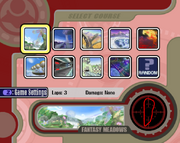
Air Ride's course selection screen
| Name | Icon |
|---|---|
| Fantasy Meadows | |
| Celestial Valley | |
| Sky Sands | |
| Frozen Hillside | |
| Magma Flows | |
| Beanstalk Park | |
| Machine Passage | |
| Checker Knights | |
| Nebula Belt* |
Courses (Top Ride)[]
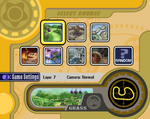
Top Ride's course selection screen
| Name | Icon |
|---|---|
| Grass | |
| Sand | |
| Sky | |
| Fire | |
| Light | |
| Water | |
| Metal |
Stadiums[]

The symbol for Stadium events
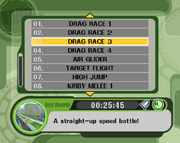
Numerous Stadium events
- Drag Race 1
- Drag Race 2
- Drag Race 3
- Drag Race 4
- Destruction Derby 1
- Destruction Derby 2
- Destruction Derby 3
- Destruction Derby 4
- Destruction Derby 5
- Air Glider
- High Jump
- Target Flight
- Single Race
- Kirby Melee 1
- Kirby Melee 2
- VS. King Dedede
Development[]

|
Main article: Kirby's Air Ride |
At first, the game was intended to be an Nintendo 64 release, but was cancelled early in its development. It was later revised for the Nintendo GameCube and released in 2003. During 2002 and the early months of 2003, Kirby Air Ride was known as "Kirby's Airland".[3]
As stated in the game's credits, the released GameCube version of Kirby Air Ride was made using the sysdolphin engine and development tools created by HAL Laboratory. This was the same engine that had been used by HAL for Super Smash Bros. Melee, and Kirby Air Ride contains some similarities stylistically to that game, despite being in a different genre.
A demo for Kirby Air Ride was released at booths during E3 2003. It included Air Ride, Top Ride, and City Trial with five playable tracks.[4]
Music[]

|
Main article: Kirby Air Ride/Music |

|
See also: Kirby Air Ride Business Trip Sound Test |
Kirby Air Ride has had its own soundtrack CD compilation released in August 2003, which was only made available in Japan.
Glitches[]

|
Main article: Glitch#Kirby Air Ride |
Reception[]
Kirby Air Ride sold 422,311 copies in Japan and 750,000 in the United States.[5][6], becoming a best-seller and receiving the Player's Choice label on later issues of the game. Upon its release, it received mixed reviews from most websites and magazines, with many praising its clean presentation and the originality of the City Trial mode while criticizing its gameplay as being overly simple. It has an average score of 65.58% on Game Rankings[7] and a 61 on Metacritic.[8] Kirby Air Ride's similarity to other titles released for the GameCube around the same time (most notably F-Zero GX and Mario Kart: Double Dash!!, both of which were made by Nintendo themselves) resulted in it being categorized as a rather throwaway title.[9] Matt Casamassina of IGN said "this racer only comes recommended as a potential buy to parents who are shopping for their under-nine son or daughter, giving the game a 5.2 out of 10.[10]
Despite these criticisms, the game currently maintains a cult following that has built up over the years since its release.[11]
Staff[]

|
Main article: List of Kirby Air Ride Staff |
Related Quotes[]
| “ | An attack-capable Air Ride machine you can assemble by combining parts A, B, and C. You can knock off parts held by foes in combat, so stealing parts is something that's sure to occur. In Kirby Air Ride, you control legendary machines, but the Dragoon not only towers above all others in terms of speed, it is also able to fly.” |
| — Dragoon trophy description • Super Smash Bros. Brawl |
| “ | A microphone who trudges along and enjoys himself as he sings. By inhaling Walky, Kirby gains the ability to shout, allowing him to clear all enemies off the screen with a high-volume blast. This is a powerful ability that can only be used up to three times. In Kirby Air Ride, this ability sends every racer within range into a spin.” |
| — Walky trophy description • Super Smash Bros. Brawl |
| “ | Broom Hatter is an apprentice witch with the hat to match. She uses her trademark broom to fly through the— Wait. No, she just sweeps the floor with it. Maybe she's just a bit of a clean freak. Or maybe she hasn't learned to fly yet. After all, she's only an apprentice. Except...in Kirby Air Ride, she DOES fly, so there goes that theory...” |
| — Broom Hatter trophy description • Super Smash Bros. for Wii U |
Regional Differences[]
Records[]
| Japanese | American | European/Australian |
|---|---|---|

|

|

|
The default option for the Records screen is switched. "Best Records" is the default in the Japanese version, but "Checklist" is the default in the American one. "Game Settings" and "Records" is known as "Settings" and "Data" in the European/Australian version.
Other Differences[]
- As in the Super Smash Bros. series, the graphic that appears at the end of a timed game (such as City Trial) reads "Time Up" in Japanese and "Time!" in other languages.
- The player and computer player identifier is #P and CP in Japanese, while it's P# and CPU in most languages.
- Every stage except City Trial is given different names in Japanese and English. Similarly, some of the Stadiums in City Trial are given different names in Japanese and English.
- The international versions added the number of completed challenges and total challenges to the Checklist screen.
- The previews from the main menu are different in the European/Australian version, with the most noticeable difference being City Trial.
- While all versions have the same vehicles, in the Japanese version all of the vehicles are lighter which makes them faster to race with.
- Distances are measured in meters in the Japanese and European/Australian versions and feet in the American version. Likewise, the speedometer measures kilometers per hour in the Japanese and European/Australian versions and miles per hour in the American version.
Trivia[]
- This was the last Kirby game that the series creator, Masahiro Sakurai, worked on as part of HAL Laboratory; after its release, he resigned from HAL and formed his own company, Sora Ltd. Two weeks after his resignation, he explained in an interview with Nintendo Dream that he had grown tired of the sequelization of his projects by HAL and Nintendo, stating that "it was tough for me to see that every time I made a new game, people automatically assumed that a sequel was coming." He would later serve as a "Special advisor" for Kirby & The Amazing Mirror and would collaborate with Nintendo and HAL (which served as Development Cooperation) to help create Super Smash Bros. Brawl.
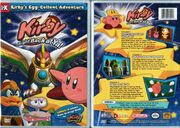
DVD box art advertising the bonus strategy guide.
- A special video strategy guide was made for the game and was exclusive to a DVD release of a Kirby: Right Back at Ya! episode called, "Kirby's Egg-Cellent Adventure."
- The US release was tied in to the first airing of the two "Air-Ride-In-Style" episodes of Kirby: Right Back at Ya! As the episodes were originally made as part of the final storyline, fans complained about the discontinuity. Comic adaptations were also released around the same time in various Nintendo Power issues.
- Music as well as the environmental settings from the anime were used in this game, as well.
- Green Kirby is seen on a Winged Star on the spine of the box art. Green Kirby is the only unlockable Kirby featured if one disregards Meta Knight.
- Super Smash Bros. Brawl's main menu screen strikingly resembles Kirby Air Ride's, and therefore might have been based off this game.
- The menu also has the same sound effects for selecting an option as Super Smash Bros. Melee.
- One of the machines in Kirby Air Ride, the Dragoon, also appears in the Super Smash Bros. Brawl, and every Super Smash Bros. title after that. It is a deadly weapon which causes an instant KO upon hitting opposing players.
- In Super Smash Bros. Melee, the crowd "aahing" and the sound that plays when the player cannot select something (such as attempting to play the slot machine with no coins) are used in this game. Also, Event 16 in this game is named "Kirby Air-raid".
- In the Music Room in Kirby and the Rainbow Curse, Kirby Air Ride is represented by an image of Kirby angrily riding a Warp Star.
- Kirby Air Ride is one of four Kirby games that has never been released as a permanent digital download, the others are Kirby Slide, Kirby Super Star Ultra, and Kirby's Dream Collection Special Edition.
- When choosing a color for Meta Knight and King Dedede, it should be noted that their colors won't match up to what is chosen. More specifically, choosing "pink" for Meta Knight would actually give him his usual colors, while yellow would make him green, green would make him pink, and purple would make him black. For King Dedede, pink would make him normal colors, red would make him green, green would make him pink, and brown would make him black.
- This is the first Kirby game where all releases share the same artwork for the box art, though Kirby's facial expression differs; he retains his classic happy smile on the Japanese box art, but has a "angry-determined" look on the American and European box art.
- Despite pre-release artwork boxes using the "Official Nintendo Seal of Quality", the first wave of game discs and boxes ended up using the "Official Nintendo Seal", making it the first Nintendo published Nintendo GameCube game to reflect the change. Several games that had Player's Choice releases after 2003 later reflected the new seal on their boxes, but their discs still used "Official Nintendo Seal of Quality".
- A 4Kids Entertainment booklet from Licensing Show 2003 states that the game was supposed to release on Game Boy Advance in addition to the GameCube version. This was likely just an error, as no other evidence implies a GBA release was planned.[12]
Artwork[]
Box Art[]
Media[]
Logo[]
Memory Icons[]
Concept Artwork[]
References[]
- ↑ Official Nintendo Japan site
- ↑ Amazon
- ↑ http://www.gamecubicle.com/news-nintendo_2003_release_schedule_japan.htm
- ↑ E3 2003: Kirby Air Ride - IGN
- ↑ Japan-GameCharts
- ↑ Next-gen.biz
- ↑ http://www.gamerankings.com/gamecube/589687-kirby-air-ride/index.html
- ↑ Kirby Air Ride - Metacritic
- ↑ Gamespot
- ↑ Kirby Air Ride Review - IGN
- ↑ Hidden Gems: Kirby Air Ride
- ↑ https://twitter.com/TanookiKuribo/status/1258063063074430981

